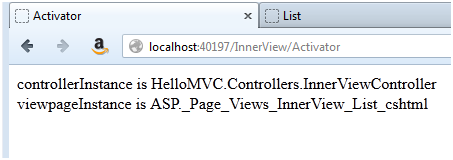[ASP.NET MVC]视图是如何呈现的 (续)
在上一篇文章中,我们知道了通过Controller执行ActionResult的Execute可以找到对应Controler对应的ViewEngine,然后在View中把Action的结果显示出来。那么ViewEngine到底是如何工作的?
我们首先从ViewReult的FindView方法开始
|
protectedoverrideViewEngineResult FindView(ControllerContext context) { ViewEngineResult result = ViewEngineCollection.FindView(context, ViewName, MasterName); if (result.View != null) { return result; }
// we need to generate an exception containing all the locations we searched … } |
根据ControllerContext和ViewName,以及MasterName找到对应的ViewEngineResult对象。我们还是以HelloController和Index为例。那么这里result将返回Views/Hello/Index.cshtml编译后的实例。我们进入FindView方法,看看其具体的实现。
上述方法调用的是ViewEngineCollection类的虚方法FindView
|
publicvirtualViewEngineResult FindView(ControllerContext controllerContext, string viewName, string masterName) { if (controllerContext == null) { thrownewArgumentNullException("controllerContext"); } if (String.IsNullOrEmpty(viewName)) { thrownewArgumentException(MvcResources.Common_NullOrEmpty, "viewName"); }
return Find(e => e.FindView(controllerContext, viewName, masterName, true), e => e.FindView(controllerContext, viewName, masterName, false)); } |
它又调用其私有的方法
|
privateViewEngineResult Find(Func<IViewEngine, ViewEngineResult> cacheLocator, Func<IViewEngine, ViewEngineResult> locator) { // First, look up using the cacheLocator and do not track the searched paths in non-matching view engines // Then, look up using the normal locator and track the searched paths so that an error view engine can be returned return Find(cacheLocator, trackSearchedPaths: false) ?? Find(locator, trackSearchedPaths: true); } |
然后又调用
|
privateViewEngineResult Find(Func<IViewEngine, ViewEngineResult> lookup, bool trackSearchedPaths) { // Returns // 1st result // OR list of searched paths (if trackSearchedPaths == true) // OR null ViewEngineResult result;
List<string> searched = null; if (trackSearchedPaths) { searched = newList<string>(); }
foreach (IViewEngine engine in CombinedItems) { if (engine != null) { result = lookup(engine);
if (result.View != null) { return result; }
if (trackSearchedPaths) { searched.AddRange(result.SearchedLocations); } } }
if (trackSearchedPaths) { // Remove duplicate search paths since multiple view engines could have potentially looked at the same path returnnewViewEngineResult(searched.Distinct().ToList()); } else { returnnull; } } |
注意,这里传入了一个Func<IViewEngine, ViewEngineResult>。输入一个IViewEngine类型,请注意ViewEngine是实际来自ViewEnglieCollection的属性CombinedItems。该对象来自IResolver<IEnumerable<IViewEngine>>接口的Current属性,其类型为IEnuerable<IViewEngine>。其实就是传入一个IViewEngine,然后一个ViewEngileResult。比如下面的例子:
|
// details of ViewEngineCollection.Find(*) Func<IViewEngine, System.Web.Mvc.ViewEngineResult> cacheLocator = e => e.FindView(ControllerContext, "ViewInstance", "", false); IViewEngine razorViewEngine = newRazorViewEngine(); System.Web.Mvc.ViewEngineResult result = cacheLocator(razorViewEngine); |
请注意,IResolver<IEnumerable<IViewEngine>>的默认实例是newMultiServiceResolver<IViewEngine>(() => Items); 【有待于确认】。我们查看其构造函数,可以发现
|
public MultiServiceResolver(Func<IEnumerable<TService>> itemsThunk) { if (itemsThunk == null) { thrownewArgumentNullException("itemsThunk"); }
_itemsThunk = itemsThunk; _resolverThunk = () => DependencyResolver.Current; _itemsFromService = newLazy<IEnumerable<TService>>(() => _resolverThunk().GetServices<TService>()); } |
也就是说IResolver的实例来自DependencyResolver.Current。通过DependencyResolver的定义,我们得知Current属性返回的单列new DenpendencyResolver.InnerCurrent,InnerCurrent其实就是newDefaultDependencyResolver()。DedendencyResolver在创建,创建单列的DefaultDependencyResolver,并将其赋值给_current和_currentCache。_currentCache对应的是InnerCurrentCache,该属性在创建View使没有使用,在创建Controller的时候会使用。
然后,调用ViewResult对象View属性的Render方法,次方法首先会创建View实例。
|
object instance = null;
Type type = BuildManager.GetCompiledType(ViewPath); if (type != null) { instance = ViewPageActivator.Create(_controllerContext, type); } |
而实际上,现在的ViewPageActivator实际是newBuildManagerViewEngine.DefaultViewPageActivator(dependencyResolver),而这里的denpendencyResolver就是DefaultDependencyResolver。
OK,我们最后来看一下instance是如何创建的:
|
_resolverThunk().GetService(type) ?? Activator.CreateInstance(type); |
请注意,_resolverThunk = () => DependencyResolver.Current;由此可见在默认的PageActivator内部的私有Fun变量_resolverThunk同样来自DefaultDependencyResolver.Current。
而instance要么DefaultDependencyResolver的GetService()创建,要么通过Activator.CreateInstance来创建,其实它们内部根本没有多少差别。
|
publicobject GetService(Type serviceType) { // Since attempting to create an instance of an interface or an abstract type results in an exception, immediately return null // to improve performance and the debugging experience with first-chance exceptions enabled. if (serviceType.IsInterface || serviceType.IsAbstract) { returnnull; }
try { returnActivator.CreateInstance(serviceType); } catch { returnnull; } } |
由此可见,GetService内部还是调用了Activator.CreateInstance方法创建实例。
剖析如何获取View的具体信息
- 获取View的Path
|
// show the details of retrieving view path publicActionResult List() { string[] ViewLocationFormats = new[] { "~/Views/{1}/{0}.cshtml", "~/Views/{1}/{0}.vbhtml", "~/Views/Shared/{0}.cshtml", "~/Views/Shared/{0}.vbhtml" };
string name = "List"; string controllerName = "InnerView"; string areaName = "";
List<ViewLocation> allLocations = newList<ViewLocation>(); foreach (string viewLocationFormat in ViewLocationFormats) allLocations.Add(newViewLocation(viewLocationFormat));
DisplayModeProvider instance = DisplayModeProvider.Instance;
for (int i = 0; i < allLocations.Count; i++) { ViewLocation location = allLocations[i]; string virtualPath = location.Format(name, controllerName, areaName); DisplayInfo virtualPathDisplayInfo = instance.GetDisplayInfoForVirtualPath(virtualPath, ControllerContext.HttpContext, path => FileExists(ControllerContext, path), null); if (virtualPathDisplayInfo == null) continue; var viewPath = virtualPathDisplayInfo.FilePath; Response.Write(viewPath); }
return View(); } |
返回结果为:

- 获取View的对象
|
publicActionResult Activator() {
// remove the dependency IDependencyResolver dependencyResolver = DependencyResolver.Current;
IResolver<IViewPageActivator> activatorResolver = newSingleServiceResolver<IViewPageActivator>( () => null, newDefaultViewPageActivator(dependencyResolver), "BuildManagerViewEngine constructor");
IViewPageActivator pageActivator = activatorResolver.Current;
// HelloMVC.Controllers.InnerViewController Object controllerInstance = pageActivator.Create(ControllerContext, this.GetType());
// Page instance IBuildManager buildManager = newBuildManagerWrapper(); Object viewpageInstance = pageActivator.Create(ControllerContext, buildManager.GetCompiledType("~/Views/InnerView/List.cshtml "));
Response.Write(string.Format("controllerInstance is {0} <br /> viewpageInstance is {1}", controllerInstance.GetType(), viewpageInstance.GetType())); return View(); } |

http://www.professionals-helpdesk.com/2012/08/exploring-mvc-framwwork-in-deep_10.html exploring MVC framework in deep – DependencyResolver Class

 浙公网安备 33010602011771号
浙公网安备 33010602011771号